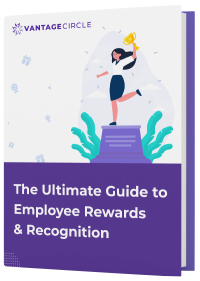The Art of Giving Recognition at Work

Workplaces are going through a dynamic transformation. Adapting itself to the changing norms of work culture is the only way for businesses to survive, sustain and thrive. One such significant change is seen for most organizations in the employee recognition space.
The power of recognition at work cannot be over-emphasized. Employee recognition is a psychologically proven way to spur motivation and development among employees. It is the primary ingredient for building an engaged workforce and creating a holistic employee experience.
Companies are now finally acknowledging the importance of rewards and recognition in the workplace.
But the catch here is that are these companies doing it the right way or blindly following the trend?
Do your employee recognition efforts live up to the expectations of the employees?
The idea of offering some recognition at work is nothing new. Getting a watch on specific years of tenure, a turkey on thanksgiving, or a gift card on Christmas are a few early examples of recognition at work.
But are these occasional, once-in-a-blue-moon gestures enough to keep employees motivated? Of course not.
Employee recognition, like every other concept, has evolved massively. Take a look at this video on the transformation of Rewards and Recognition in the workplace.
Employees now have huge expectations from their employers. To meet the changing needs of the people and match the expectations of the new generations in the workplace, it only makes sense to re-evaluate the rewards and recognition efforts of the organization constantly.
The entire job market scenario has changed over the last few years. The war for talent is real. Employees are now choosing their employers (not the other way round).
Not surprisingly, the current dominating forces (Millennial & GenZers) in the workforce are tough to please. They don’t see recognition as a memorable affair. They feel they are entitled to receive recognition for a job well done. Giving recognition in a manner that would appeal to them is necessary to attract, retain and satisfy them.
If all the points mentioned above aren’t enough to cement the importance of rewards and recognition at work, here are a few statistics for you:
-
23% of employers offered additional recognition programs to stay competitive in attracting and retaining talent. (SunTrust)
-
26% of employees ranked recognition for their work in their top three factors for staying with their current employer. 17% said their manager/employer was horrible – they never recognized their work. 43% ranked their manager/employer as just okay – recognizing them annually or quarterly at least. (Achievers)
-
About 50% of senior managers view recognition as an investment. (Maritz & WorldatWork)
-
About 85% of professionals prefer a simple “thank you” as recognition for their day-to-day work. (Deloitte)
Related: 32 Rewards and Recognition Ideas to Boost Employee Recognition [2019 Updated]
Presenting 5 Distinct Ways that employees (actually) prefer to receive recognition at work:
1. Boost Peer to peer recognition
We, humans, are essentially social beings. We have an inherent need to be appreciated and treated well by the people in our surroundings.
In the work environment, your people spend a substantial amount of time with their colleagues. They have better interpersonal relations with their peers than, say, managers and employers.
Also, modern workplaces are transforming from being competitive to collaborative in nature. Teams collaborate rigorously daily to get the best results.
In such a situation where peer interactions are high, and teamwork is a necessity, peer recognition is something that companies must promote. Employees naturally feel recognition is meaningful when it comes from someone from their peer group.
Moreover, when the organization promotes a culture of gratitude and appreciation, internal communication becomes better, and there are lesser chances of stress and conflict.

To sum up, employees share stronger bonds with their peers than their managers. They also feel that sometimes appreciation from managers is forced and not genuine. On the other hand, when recognition comes from peers, it is considered more meaningful. Companies should facilitate a culture where peer recognition becomes frequent and natural.
2. Leverage Social media
Why social media, you ask? Because everyone’s doing it.
For the current generations, nothing is considered to have happened unless it’s on social media.
Something is compelling about being recognized on social media by a company with tens of thousands of followers. Social media recognition gives your employees the feeling of being truly in the limelight. Also, flaunting hard-earned appreciation for their excellent work becomes easier on these platforms.
For example, even the “employee of the week” or similar recognition ritual will immediately become more meaningful when you post a picture of them on the company’s social media handle.
A big plus about going to social media for recognition is gamification. Employees can nominate or vote among themselves for important awards and recognition. You can reward the team or department that shows a great achievement in social media together. It encourages employees to work together as a team and not just as an individual all the time.
Another great way of recognizing employees is through cloud-based internal employee recognition programs. Companies now have their R&R platforms that can act as a mini social media where employees can indulge in staff recognition, exchanging good wishes on birthdays and work anniversaries, on-the-spot compliments, and more. Also, it becomes easier to integrate reward points in such platforms. Managers can make the whole recognition process more effective by adding incentives and a recognition leaderboard.

Some other employee recognition ideas that work in social media can be:
- A Letter of excellence by a leader/ team members/ managers on special achievements and milestones.
- A monthly online newsletter with special mentions and shout-outs to all the monthly award winners.
- A virtual wall of fame for the recognition-worthy remarks every week.
3. The Era of Instant gratification
There has been a profound shift in our society in the past few decades. The millennials and the GenZers dominate the workforce and are rightly termed as “impatient” and “fast-paced”. They want to get their job done quickly, and they expect instant recognition for the same. Delayed recognition is as good as denied credit for today’s multigenerational workforce.
Applying good encouragement tactics is crucial for any organization. Sincerity and timeliness of feedback and appreciation might seem trivial, but it makes much difference. When we talk about recognizing an innate part of the company culture, we must make recognition as regular and instant as possible.

Recognizing achievements in real-time or trying to schedule them as close to the actions you’re rewarding reinforces the behaviors you want to encourage. Also, as a result, employees become aligned with broader company goals.
When employees know that you will praise them and their efforts wouldn’t go unnoticed, they are more likely to take up challenges and continue growing. It empowers them by giving them the extra boost of confidence.
Additionally, expressing interest in their professional development, sending them emails about their progress, and assisting them in their journey help you reach the broader company goals faster. It is a definite win-win situation for both employers and employees.
4. Gift of “Time-off”
Striking the perfect balance between work, career, family, and fun has been the biggest challenge for employees. Work schedules are getting busier, and personal time is getting shorter.
Naturally, a healthy work-life balance in flexible timing and time-off is the top-seeking benefit for employees everywhere.
Giving extra time off not only shows your appreciation but is something employees want at the end of the day.
To make recognition truly meaningful, you must break off from traditional practices and adopt modern ones. When an employee goes above and beyond to get a particular piece of work done, you can give them an extra day or two off or a short paid holiday to show them that they truly deserve a pat on the back. Doing so will boost their motivation and at the same time present a caring image of the company.

Offering time-off is a good gesture, but it is also great from the company’s perspective. When employees do not take time off to rest, it wears their bodies down. Burn-outs become common, and they are more susceptible to illness and other health conditions. These often lead to high absenteeism, low productivity and more company health costs.
Flexible work timings are an initiative that all companies will be bound to adopt very soon, so why not make it a way to recognize your employees?
5. Power of Personalization in rewards and recognition
Personalization is not a trend, it’s a marketing tsunami. – Avi Dan
Rewarding employees doesn't need to be a one-size-fits-all solution. Everybody loves a personalized approach. But when it comes to motivating employees, there are two main factors- Extrinsic motivation and Intrinsic motivation. And there has been this constant debate between Extrinsic vs. Intrinsic motivation, but the idea is to find the balance while recognizing your employees. This is where personalization steals the show!
Employees have different expectations and different goals that they want to achieve in their career trajectory. If you're going to acknowledge your employees’ hard work, it’s essential to get to know them personally and understand what motivates and drives them.
One of the main reasons behind recognizing employees is encouraging them to deliver similar results in the future. For this, employees must have the freedom to choose an award that’s relevant to their personal lives.
Impersonal rewards are perceived as hollow and often do more harm than good.
But the question is how to personalize rewards? How to find out what they would like to have?
The first solution to that would be by asking them through surveys and emails. A quick survey before the recognition program can help you learn a lot about their preferences. You can also provide them with a plethora of reward options to choose from.

The following solution that I would like to mention here is a Point-based rewarding system.
When you have trouble discovering a gift that suits a particular person, a point-based rewarding system can come to your rescue.
In a point-based rewarding system, each employee is part of an employee rewards program where the management can allot points to their employees as gifts or rewards. The employees can redeem these points earned by them and use them to buy goods/services of brands from different categories – like merchandise, travel, lifestyle, etc. – available on the platform.
You can leverage such an appreciation program for the employee that shows positive qualities at the workplace. Points could be awarded to the employee for simple tasks like assisting their colleagues with their punctuality or other attributes.
Vantage Circle offers such a unique employee recognition program, Vantage Rewards.
Take advantage of this flexible, personalized recognition platform through which employees can choose from thousands of gift card options for popular, local stores, restaurants, entertainment or travel outlets, and even charitable organizations.
The employee can use rewards credit to redeem gift cards for diverse brands and organizations like Apple and Amazon, delivering exactly what millennials want in the workplace: creative and personalized recognition.
Final words:
Traditional recognition programs breed cynicism and apathy and come across as a one-size-fits-all approach(mostly done to make the organization look good). But the modern workforce expects their workplace recognition to be tailored to them, given for something that matters and not always the same thing. I hope this article helped you in understanding the upcoming trending in employee recognition practices. If you have any more suggestions and inputs, do let us know in the comment section below. I’m excited to hear from you!

Vantage Circle is a simple AI-powered Rewards & Recognition Platform for upgrading your employee experience and engagement for better productivity.






